Before You Call the Vet: 3 Easy Steps to Get a Baby Lamb or Kid on a Bottle and Save Her Life
If you raise sheep or goats on your homestead, you will inevitably have the occasional baby lamb or kid that is born prematurely. Being able to quickly get the kid or lamb on the bottle may save the baby. Before you call the vet, try these 3 easy steps to save her life.
Today there is a baby angora goat in a box in my kitchen. She was born premature and is not yet standing. When she came into the house on Sunday, she was limp and cold. She hadn’t yet fed on her mom. If you raise sheep or goats on your homestead, you will inevitably have the occasional lamb or kid that is born premature, or one is weak and gets cold before they get that first life-giving suck of colostrum.
This becomes an emergency. You have only minutes to get the life-sustaining colostrum into the baby before you lose her.
Goats and sheep are born hypoglycemic. They have only about 30 minutes before they must have colostrum or they will become too weak to find it. This is nature’s way of preserving the flock, taking care of the weak, and keeping the herd safe from predators. In the majority of births, the mother and the baby will work together to get the baby on the teat.
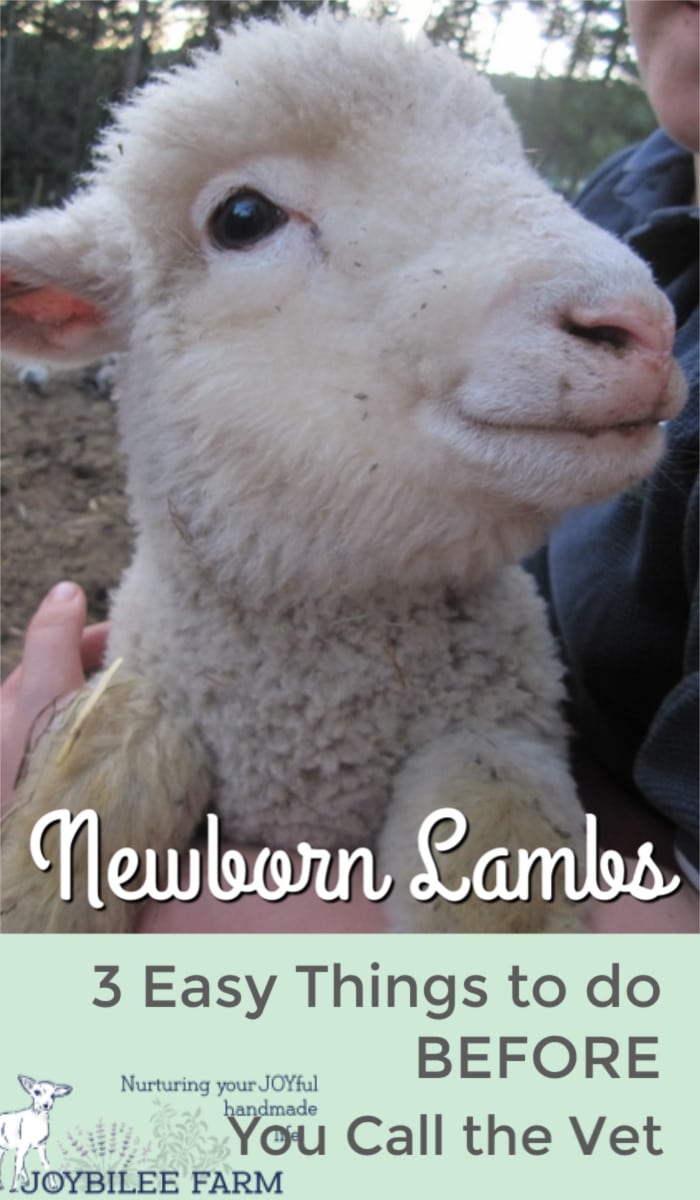
The mother stimulates the baby by licking, and the baby begins to bob its head, looking for the teat, while at the same time trying to stand up. Strong babies will be on the teat in 10 minutes or less. But if the baby isn’t responding this way, you can increase its survival chances by prompt intervention. Without intervention the baby will soon weaken and give up trying to find the teat, ultimately ending in tragedy.
Other factors can increase the likelihood of the need for intervention by you. Early Spring births can chill a wet baby and reduce the chance of the baby finding the teat before it’s too late. Kids and lambs that are born prematurely will be unable to stand to get under their Mom. A difficult birth can mean that the baby, already exhausted from the birth, may not be on its feet right away. In these cases, being able to quickly get the kid or lamb on the bottle may save the baby.
We keep a 4-ounce baby bottle and nipple in our barn emergency kit, for these occasions. It’s easier to milk out 4 ounces of colostrum from the Dam than to fight with a weak baby to get it on the teat. After the first 4 ounces of colostrum are into the baby, you will have more time to work with both the dam and baby to get them together.
Milk out the mom directly into the clean baby bottle
Step 1. If the goat or sheep is a first-time mom, you may need someone else to hold the animal still so you can milk out the teat into the bottle. If the animal is an experienced Mom, she will understand what you are trying to do and be more cooperative.
Cover the baby lamb’s eyes
Step 2. Put the baby on your lap. The baby will still be wet from birth, so you’ll want a towel to protect your lap and if the baby is cold you can wrap them in the towel, while you try to feed them.
Since baby goats and kids feed underneath their dams, they are programmed to start sucking when they are in darkness. You can simulate this by covering their eyes when you offer the bottle. The baby will respond by sticking out their neck and turning their nose upward to look for the teat. Do this with the same hand that you are holding the bottle in. Make sure that you hold the bottle outward so that the baby has to stretch its neck to feed. This will allow the baby to bypass the first stomach and place the milk in their second stomach, where it belongs.
Flick the baby lamb’s tail
Step 3. With your other hand, once the bottle is in the baby’s mouth, you want to gently flick the tail. The mother does this to get the baby under her and then continues licking the tail, while the baby is sucking. This encourages the baby to suck more.
So by flicking the baby’s tail with your finger, the baby will respond by sucking at the nipple of your baby bottle. A strong baby that is just slow, will begin to suck immediately and will finish a 4-ounce bottle in a few minutes. A cold baby, may only hold the nipple in her mouth and let the colostrum drip down its throat. Don’t allow the baby to aspirate the bottle contents or they will drown.
If you have a healthy, strong kid, these 3 steps will have the kid on the bottle quickly and you will then have time to work with the kid to get it under its dam. But if the baby doesn’t respond there are a few things you can do to save the kid or lamb, before it’s too late.
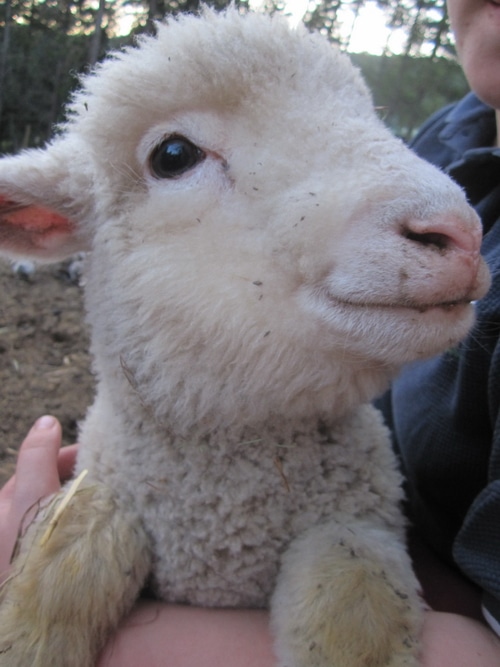
If the baby is weak or cold give the baby lamb or kid an sq shot of e-sel (vitamin E and Selenium).
A lack of selenium is very common in Western North America, and a deficiency can cause muscle weakness, premature birth, and retained placenta. By giving a shot of 2ml of selenium at birth, you strengthen the newborn. If a newborn requires a shot of selenium, and it is one of a twin, give the twin a shot as well, even if the twin seems stronger.
To give an sq shot you will need to pinch up a fold of loose skin. You can do this easily on either side of the backbone, along the rib cage.
- Pinch up a fold of skin.
- Insert the needle in the skin fold. Make sure the needle doesn’t go through the skin to the other side or you will just push the medicine into the air.
- Release your hold on the skin so that it falls back naturally. Push the contents of the needle into the baby by pressing down the plunger on the syringe.
- Remove the needle and rub the area where the medicine went in, to move it around, through the baby.
Lambing Troubleshooting Tips for Newborn Lamb or Kids
How to warm a cold baby lamb
First, use a hairdryer, a hot water bottle, or a warm flax bag to warm the baby. You can tell if the baby is cold by touching the baby’s tongue with your finger. If a baby lamb is cold, it will be unable to suck and swallow. The first sign of hypoglycemia in the newborn is a cold tongue. If you can’t get warm colostrum in the baby lamb because it is cold, warm the baby before trying again. You can put the colostrum in a cup of hot water to keep it warm, while you work with the baby. (never microwave colostrum)
Dry the baby completely with a towel. Rubbing the baby with the towel stimulates the Mother’s licking and will get the baby warm faster, than just putting it by a heater.
In an emergency with a very cold baby, you can immerse, up to its neck, in a sink of warm water (101F is about right). Support its head and keep it in the water until the tongue is warm. In this case, though, you will wash its birth smell off, and its mother will not recognize it. You will most likely have a permanent bottle baby to take care of, so only do this as a last resort, after you have tried all other means to warm the baby.
Whether you begin with a baby that is cold and wet from birth, or you have needed to immerse the baby in warm water, rub the baby vigorously with a towel to dry it, and then finish drying it with a warm blow dryer. Keep the dryer moving constantly so that you don’t burn the baby’s delicate skin.
Once the baby is completely dry, check the tongue. Is it warm yet? If at this point, you have not yet gotten 4 ounces of colostrum into the baby, try again now. Drinking warmed colostrum will help the baby’s core to warm, too.
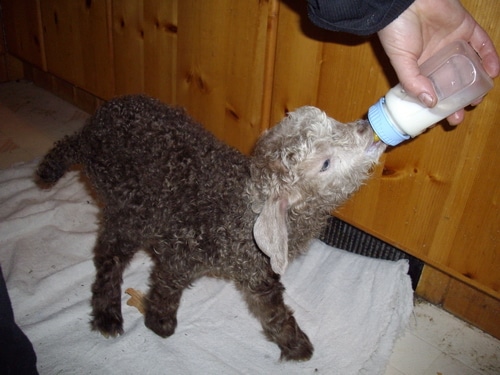
Baby goats and lambs are born hypoglycemic. You have only 30 minutes to get them on the bottle and save their life. Here’s what to do in this emergency.
Create a warming box for a baby lamb or kid
If the baby’s tongue is still not warm, with these steps, you will need to create a warming box to place the baby in. Find a box or basket that the lamb will fit into. The box or basket should be small enough that it forces the baby to lie in a natural position with the head up or tucked over the back. This will help the baby breathe and swallow without aspirating its stomach contents.
You will need a flax bag or a hot water bottle. Heat it well and wrap it in a towel. Place it in a box or basket and place the baby on top of it and then put a warmed towel on top of the baby. After 30 minutes the baby’s tongue should be warm.
At this point, if you haven’t already, try and get the warmed colostrum into the baby.
What to do if the baby lamb is premature:
If you have a premature baby lamb, when you open the baby’s mouth there will be gums but no teeth, and the baby will be unable to stand. You may need to keep the baby in the house for a day or two until you get it up on its feet. In this case, if you don’t want a bottle baby, make sure you only give the baby its own mother’s milk to drink, and that you take the baby out to its mother occasionally so that she can smell it and lick it.
This will keep the mother from getting depressed and will help the baby to know its own mother.
If you do have a bottle baby, you will only need to take the first three steps to get the baby on the bottle, over the first 2 or 3 days. After that, just seeing the bottle will trigger the baby to butt the bottle and begin to suck. Bottle babies are very cuddly and fun to be around for the first 4 to 6 weeks. You can wean them onto grass and hay any time after this.
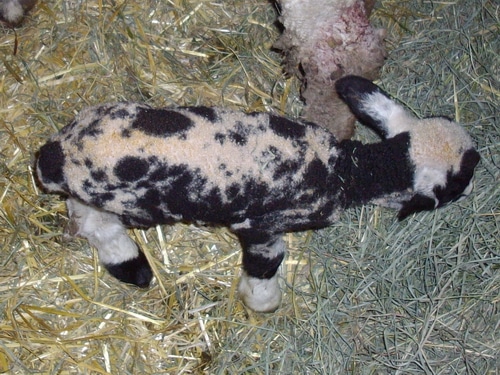
Minerals in the Barn
If you have a lot of weak or chilled babies, your mothers may need a change in their minerals.
We give every adult animal a shot of e-sel in the Fall before breeding and in the Spring about 4 weeks before our first expected kidding/lambing. The pastures in Western North America are generally selenium deficient. Read more in this article: Selenium supplementation: a matter of life and death in your flock.
We also offer loose minerals for both sheep and goats. Goats require more copper than sheep and if you are keeping both, your goats will need a loose mineral to which copper has been added. These minerals should be fed in an area that your sheep cannot access. Copper is toxic to sheep.
If you are raising both sheep and goats together and only the goats produce weak babies, consider copper deficiency as the cause of the weakness. If you correct this as soon as you suspect it, you may prevent your remaining mothers from giving birth to weak or premature babies. Goats respond quickly to an increase in minerals.
Caprine Arthritis Encephalitis
If adding additional loose minerals doesn’t change things for you, your herd may be suffering from CAE (Caprine Arthritis Encephalitis). This is a disease that is passed on from mother to baby through tainted milk and birth fluids. It is similar to AIDS in humans.
Animals with this disease will die prematurely, give birth to weak kids, and be generally weak and unthrifty. It can be prevented by beginning with disease-free stock. If you already have it in your herd, you can prevent it in the offspring by catching them at birth and raising the kids on pasteurized milk. The carriers should be culled from your herd, as soon as you have replacements that are disease-free. The disease, like AIDS, is passed through body fluids.
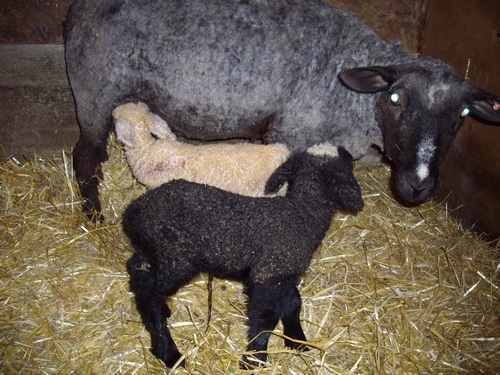
Newborn lambs
Consult Your Vet
If these steps don’t correct an epidemic of weak and chilled babies consult your vet. Numerous things can cause the loss of newborn sheep and goats on your homestead. I’ve mentioned only the major ones. If you’ve exhausted the list, a vet has access to tests that may help you narrow down the problem on your own homestead and help you find a solution.
Inevitably you will have some losses. You do the best you can and then you have to leave the rest up to God. Hopefully, this article will help you have fewer losses on your homestead and empower you with the skills to save more babies and have more successes, too.
This is part 1 of a series of articles on saving baby goats and kids.
Part 2: No Time to call the vet: Dealing with hypothermia in baby goats and lambs
Part 3: 3 natural ways to help a lamb with a broken leg mend



Is the bottle too fast for her. Check and make sure that the nipple hasn’t been opened too much.
My baby black belly Barbados lamb is couphing after she drinks from her bottle shes three weeks old
Thanks for sharing your knowledge with us. So grateful.
This article just saved one of our babies lives!! Got her sucking. Thanks!